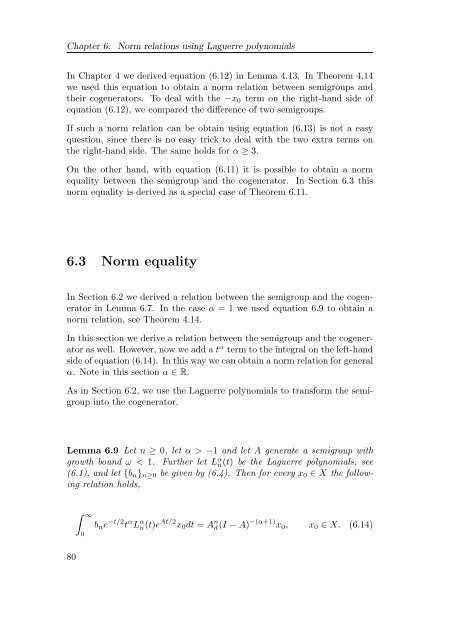PDF - Universiteit Twente
PDF - Universiteit Twente
PDF - Universiteit Twente
You also want an ePaper? Increase the reach of your titles
YUMPU automatically turns print PDFs into web optimized ePapers that Google loves.
Chapter 6. Norm relations using Laguerre polynomials<br />
In Chapter 4 we derived equation (6.12) in Lemma 4.13. In Theorem 4.14<br />
we used this equation to obtain a norm relation between semigroups and<br />
their cogenerators. To deal with the −x0 term on the right-hand side of<br />
equation (6.12), we compared the difference of two semigroups.<br />
If such a norm relation can be obtain using equation (6.13) is not a easy<br />
question, since there is no easy trick to deal with the two extra terms on<br />
the right-hand side. The same holds for α ≥ 3.<br />
On the other hand, with equation (6.11) it is possible to obtain a norm<br />
equality between the semigroup and the cogenerator. In Section 6.3 this<br />
norm equality is derived as a special case of Theorem 6.11.<br />
6.3 Norm equality<br />
In Section 6.2 we derived a relation between the semigroup and the cogenerator<br />
in Lemma 6.7. In the case α = 1 we used equation 6.9 to obtain a<br />
norm relation, see Theorem 4.14.<br />
In this section we derive a relation between the semigroup and the cogenerator<br />
as well. However, now we add a t α term to the integral on the left-hand<br />
side of equation (6.14). In this way we can obtain a norm relation for general<br />
α. Note in this section α ∈ R.<br />
As in Section 6.2, we use the Laguerre polynomials to transform the semigroup<br />
into the cogenerator.<br />
Lemma 6.9 Let n ≥ 0, let α > −1 and let A generate a semigroup with<br />
growth bound ω < 1. Further let L α n(t) be the Laguerre polynomials, see<br />
(6.1), and let {bn}n≥0 be given by (6.4). Then for every x0 ∈ X the following<br />
relation holds,<br />
80<br />
� ∞<br />
bne<br />
0<br />
−t/2 t α L α n(t)e At/2 x0dt = A n d (I − A) −(α+1) x0, x0 ∈ X. (6.14)
















